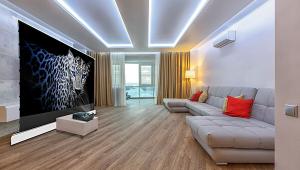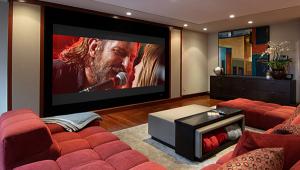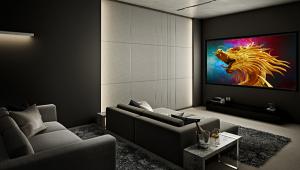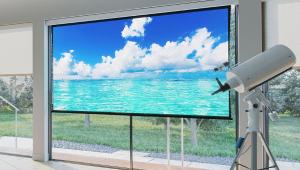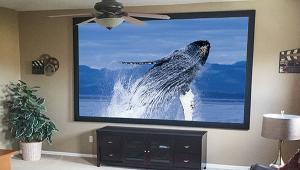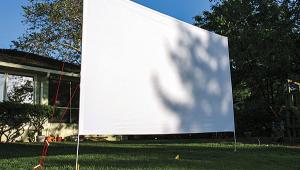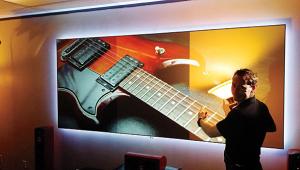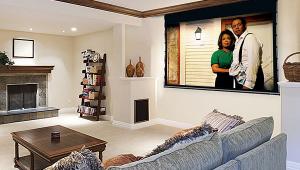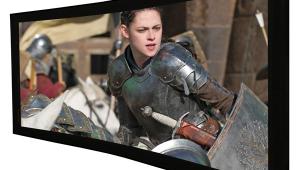Screening Your Room: Stewart Filmscreen StudioTek 100 and StudioTek 130 G3 Page 2
To see how your viewing angle affects gain, or luminance, check out Figures 1 and 2. They show the specified dispersion characteristics of two different screens from Stewart Filmscreen. Figure 1 is the UltraMatte 200, a screen with a gain of 2.0. This screen can produce a very bright image if you’re in the center seating position. However, the brightness falls off quickly as you move to the side. It drops to half of its peak value at 26 degrees. Compare that with the StudioTek 130 G3 (Figure 2), one of the most popular home theater screen materials ever produced. You’ll need to move 68 degrees to the side before the visible brightness, or luminance, degrades to half of its on-axis value.
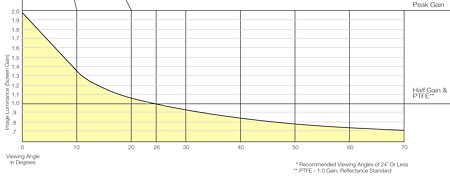
Figure 1: Stewart Filmscreen UltraMatte 200: Luminance vs Viewing Angle
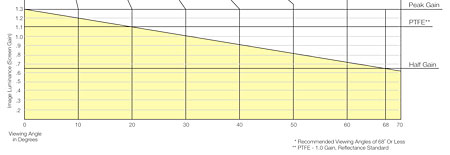
Figure 2: Stewart StudioTek 130 G3: Luminance vs Viewing Angle
How Close Do I Sit?
You can compensate for a smaller screen by simply sitting closer to it. But how close is close, exactly? Recommendations are generally based on the viewing angle, the left-to-right angle that the image covers in your front field of vision. These typically range from 30 to 40 degrees for high-definition sources. Even larger angles have been mentioned, but they’re mostly for viewers who regularly grab the front row at the movies.
Here are some formulas that will make it easier to calculate the viewing angle. For 30 degrees, the viewing distance equals 1.87 times the screen width. For 35 degrees, it’s 1.59 times, and for 40 degrees, it’s 1.37 times. If you’d like the easy route, go to myhometheater.homestead.com/viewingdistancecalculator.html and simply drop in the appropriate numbers. If you use the screen width measurement, you can use this calculator for a screen with any aspect ratio, such as 2.35:1. You’ll only need the width and viewing distance to calculate the viewing angle.
For example, if you sit 12 feet from a 100-inch-wide, 2.35:1 screen, the viewing angle is 38.3 degrees. If you’re viewing a 16:9 (1.78:1) image on the same screen, it would be 75.74 inches wide (100 / 2.35 = 42.55 inches high; 42.55 x 1.78 = 75.74 inches wide). That equals a viewing angle of 29.5 degrees with a 16:9 image from the screen at the same 12-foot distance. It should be obvious that we’re only talking about projection. A small flat-panel display with a similar viewing angle will have a setup that only one person, or two very friendly people, could love.
A Tale of Two Screens
Perhaps the two best-known companies in the home theater screen business are Da-Lite and Stewart Filmscreen. (They are both widely respected for their pro and theatrical screens as well.) To provide us with a look at two of its premier lines, Stewart lent us fixed-frame versions of its StudioTek 130 G3 and StudioTek 100 screens.
The StudioTek 130 G3 is a white screen with a rated gain of 1.3. This modest gain was originally intended for use with CRT projectors (the first StudioTek 130s were introduced in the early 1990s). They’ve also proven to be effective with modern digital projectors, particularly when you need a large screen. As I mentioned earlier, the newest StudioTek 130 G3 is rated to produce half its on-axis luminance at 68 degrees. Our sample was 78 inches wide.
These characteristics mean that the StudioTek 130 G3 should give you a bright (but not overly bright) image in the center of the screen. The falloff toward the sides should be low enough to minimize center hot-spotting and high enough to ensure that enough room reflections don’t wash back on the screen to seriously degrade the contrast. Note that we’re talking about reflections back from the projected image, not room lighting. Both of these screens require a darkened room to perform their best.
The new StudioTek 100 is a refinement of Stewart’s long-established SnoMatte 100. With a rated gain of 1.1, it’s specified to minimize loss of luminance at increasing off-axis angles. In technical terms, it has diffusion characteristics close to those of a perfect Lambertian surface. In fact, Stewart specifies the gain at 70 degrees off axis to be nearly the same as it is on axis. That means that any seating position should be as good as any other, with no hot-spotting of any kind. Our StudioTek 100 was 100 inches wide. It had a 2.35:1 aspect ratio, although I only used the center 16:9 section for the measurements.
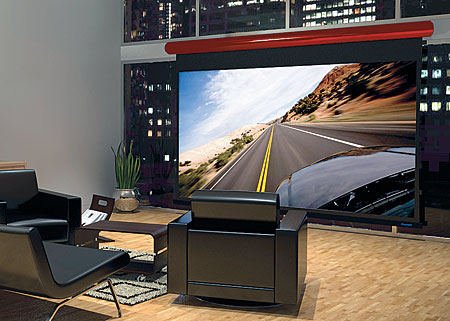
The StudioTek 100’s downside is that more light comes off the screen at wide angles. This can cause more reflections from nearby light-colored walls and other surfaces than with other screens. Stewart only recommends the StudioTek 100 for the sort of dark environment that you’re likely to find in a professional installation or very serious home theater (no ambient light, all nearby surfaces painted a non-reflective, very dark gray or black). This screen material is also not recommended for use with Stewart’s CineCurve screens since reflections from the curvature would reflect directly back onto the screen and decrease the image contrast.
To test both screens, we set them up in our testing studio, a space very similar to the pro environment that Stewart recommends for the StudioTek 100. The walls, ceilings, and carpet are a dark, neutral gray, and there are no windows.
I ran several tests on both screens. First, colorimetry. I checked the color tracking at seven different points on each screen. The meter (a Minolta CS-200 colorimeter) remained in the same position (just behind the projector), and I rotated and/or tilted it as necessary to aim it at the area I was measuring. To keep the number of data points from getting out of hand, I took all of the readings from the upper left quadrant of the screen (center to left, center to top, and diagonally to the upper left-hand corner). The consistency of the other quadrants on each screen was a fairly safe assumption based on Stewart’s known manufacturing methods. Any inconsistency would likely say more about the projector than about the screen.
In fact, there was no way for me to separate the effects of the projector (an Epson PowerLite Home Cinema 6500 UB LCD model) from the screen itself in the color-tracking measurements. Some, perhaps even most, of the deviations between the calibrated center measurement and the color tracking at other points is probably due to the projector. We aren’t looking for each screen’s color tracking. Instead, we’re looking for the differences between the screens as measured at the same points.
Note: The Where to Buy link below is an affiliate link. If you purchase through the link, we may earn a small commission at no extra cost to you. Thank you for your support!
